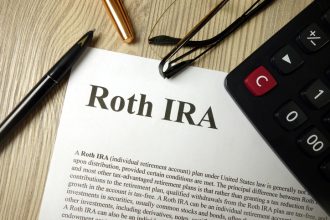According to The Federal Reserve, the median retirement account savings for households between ages 55 and 64 is roughly $185,000. While this is a considerable amount of money, it’s probably not enough to secure a comfortable retirement for most people. A standard household making the median income will likely want between $415,000 and $825,000 in assets as they enter their 60’s to maintain their standard of living in retirement. With full retirement age at 67, at age 60 there’s still some time left to accelerate your savings, but it will take some work. Here’s what you need to know.
If you’ve fallen behind on your retirement savings, a financial advisor can help adjust your retirement plan for your needs and goals.
Average Savings By Age 60
Measuring an ordinary household’s savings can be difficult. Among other issues, it’s difficult to know exactly which assets to measure. For example, should economists consider just tax-advantaged retirement accounts? Should they include private portfolios? Cash? Potentially valuable personal property?
Then, there’s the question of statistical analysis. The Federal Reserve provides data on the median and the average assets of American households. Median is the measure of a data set’s midpoint. So, the median savings is the number at which half of all households have more than this amount and half of all households have less. Average is the measure of a data set’s trend and tendency. So, the average savings is the number at which half of all money saved is above this amount and half of all money saved is below it.
According to the Federal Reserve, households between the ages of 55 and 64 have the following median assets:
- Retirement Accounts – $185,000
- Other Financial Assets – $67,700
- Home Equity – $350,000
- Total Net Worth – $364,270
According to the Federal Reserve, households between the ages of 55 and 64 have the following average assets:
- Retirement Accounts – $537,560
- Other Financial Assets – $150,660
- Home Equity – $504,420
- Total Net Worth – $1.56 million
The difference is important, because averages are relatively easy to skew with outlying data. In the case of the U.S. economy, a small number of households hold vastly more wealth and assets than most others. This skews the average result upwards, making it look like most Americans have more money saved than they actually do.
When the Federal Reserve looked at how much money Americans have saved for retirement, it found a mid-range of around $185,000. This is the most representative number for how much a mid-range U.S. household has saved by age 60. About half of all households have more saved than that, about half of all households hold less.
Among the households with more in savings, some have such large retirement accounts that they bring the average savings up to $537,560.
How Much Should You Have Saved for Retirement?

How much should you save for retirement depends significantly on your personal income and lifestyle.
Generally, financial experts assess retirement savings by age and multiple of your income. As T. Rowe Price wrote in one representative piece, most households want to target retirement savings of:
- Age 30 – 0.5 x Your Current Salary
- Age 40 – Between 1.5 and 2.5 x Your Current Salary
- Age 50 – Between 3 and 6 x Your Current Salary
- Age 60 – Between 5.5 and 11 x Your Current Salary
So, for example, say you make $50,000 per year. Based on this advice, to retire with your current standard of living you would want to have between $150,000 and $300,000 in savings at age 50.
So, by age 60 the amount you should have saved up will depend significantly on your income and lifestyle preferences. At the time of writing, the U.S. Census calculated that the median household income in America was around $75,000. Going with the standard rule of thumb, then, by age 60 a median household should have between $412,500 and $825,000 in retirement savings. This is the amount that most advisors would recommend to maintain a standard of living in retirement at the median level of income.
Building Up Retirement Savings
The gap between what most Americans have and what they need could indicate a growing crisis in retirement. Most households have less than half of what they’ll need for a comfortable retirement. Even the higher savings of an average household, skewed up by wealthy outliers, only meets the lower-end of what most advisors would recommend for a median family.
If you’ve fallen behind on your retirement savings goals, perhaps the first place to start is through catch-up contributions. The IRS allows households to contribute additional money to tax-advantaged retirement accounts such as 401(k) and IRA plans after the age of 50. This can help you save an additional $7,500 in 2024 for a 401(k) and an extra $1,000 for an IRA.
At the same time, if you do not have an IRA, consider opening one. These self-directed accounts can be an excellent way to supplement an employer-sponsored retirement program, giving you strong tax benefits that can make it much easier to save.
Finally, consider delaying your retirement until age 70. While this may not be practical for everybody, those extra three years of work will give you two main benefits. First, it’s three more years of saving and growth for your retirement account. For example, at the S&P 500’s average 10% rate of return, that could be the difference between boosting a $185,000 portfolio to $360,000 at age 67 vs. letting it grow to almost $500,000 by 70.
Second, retiring later this will allow you to maximize your Social Security benefits. By waiting until 70 to collect benefits, you will receive larger payments for the rest of your life, significantly extending the life of your retirement account due to the supplemental income.
The average retirement account is only a general reference. A better question could be how much do you have when compared with what you’ll need. And making sure you meet your own needs is absolutely critical.
Bottom Line

The median household has about $185,000 in retirement savings between the ages of 55 and 64. Although this sounds like a lot of money, it’s about one-fourth of what most financial experts recommend you have saved up.
Retirement Planning Tips
- A financial advisor can help you build a comprehensive retirement plan. Finding a financial advisor doesn’t have to be hard. SmartAsset’s free tool matches you with up to three vetted financial advisors who serve your area, and you can have a free introductory call with your advisor matches to decide which one you feel is right for you. If you’re ready to find an advisor who can help you achieve your financial goals, get started now.
- If you’re worried about not saving enough for retirement, SmartAsset’s free calculator can help you estimate how much you will need.
Photo credit: ©iStock/JLco – Julia Amaral, ©iStock/shapecharge, ©iStock/Drazen Zigic
Read the full article here
















